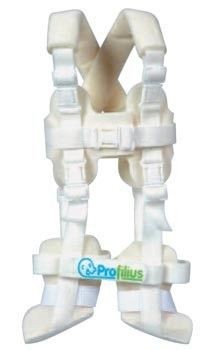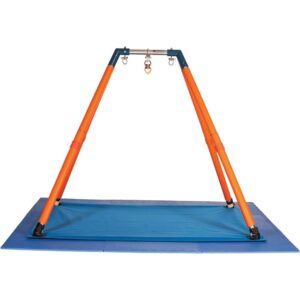Pavlik Profilius belts
0,00 €
To order
Pavlik belts for hip replacement therapy, which are used to treat hip dysplasia.
Hip dysplasia is one of the most common congenital defects in newborns. Hip dysplasia is an immaturity of the joint that appears at the moment of the child’s birth, but is not affected by childbirth. Dysplasia has different degrees of severity, in most cases the hip bone and femoral head are underdeveloped. The hip joint is made up of the femur and pelvis, the accompanying joint capsule, ligaments and muscles. In the case of the simplest disorder, hip dysplasia, the so-called roof of the pelvic bone that forms the joint is not sufficiently developed by the time of birth. If the development remains incomplete and the “roof” has not been formed by the time the child stands on its feet, a dislocation of the hip joint may occur.
Why does this developmental disorder occur?
It’s hard to say why. In part, this disorder is hereditary, while illnesses during pregnancy, the risk of miscarriage and metabolic disorders play a role.
The risk group includes:
- children with high birth weight;
- premature babies whose hip joints are immature and the joint capsule is loose;
- babies who have been in an unfavorable position in the womb, such as breech position;
- children born from multiple pregnancies;
- predisposition: if someone in the family has had a hip joint development disorder, the risk of getting sick is much higher.
Developmental disorder occurs 5-6 times more often in girls than in boys.
How is the disease diagnosed?
In the maternity hospital after the birth of the child, the condition of the hip joints is also checked during the examination of the newborn. When the newborn’s legs are bent at the hip, a clicking sound is felt in the hip joint. Afterwards, the clicking is no longer felt. It is important to pay attention to the difference in the mobility of the hip joints, the asymmetry of the thigh and buttock folds, the different length of the limbs.
When should you see a doctor?
A family doctor sends a referral to an orthopedist’s appointment or an ultrasound examination of the hip joints. For babies under 3 months of age, an ultrasound examination helps to clarify the diagnosis, for older children, an X-ray is taken. In the case of hip dysplasia discovered in a newborn or in the first or second month of life, the orthopedist prescribes Pavlik straps or abduction pants for the replacement treatment of the hip joints. The chosen tool keeps the child’s legs in a frog position and thus creates favorable conditions for the development of the hip joint. The child should not be supported on the legs until the joint is sufficiently developed. If necessary, the doctor sends the infant to a physiotherapist for functional follow-up treatment. After the fixation treatment, it is useful to put the child on his stomach as often as possible to strengthen the shoulder girdle and back muscles. Swimming is recommended after treatment. The child makes movements in the water that improve muscle cooperation and balance and joint mobility. If swimming is not possible, exercises can be done in a large bathtub.
If the development problem of the hip joint has not been detected on time in the 3rd-4th year. month of life, the treatment is longer. A child older than six months may need stretching therapy and a cast.
If the disease is detected early and treatment is started immediately, the prognosis is good. If the disease is detected early and treatment is started immediately, the prognosis is good.
| Store | Address | Quantity |
|---|
The customer can return goods purchased from the Tervise Abi OÜ e-store within 14 days of receiving the goods using the right of withdrawal. For returns, read more information here.







